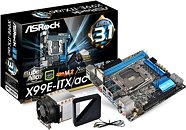Monday, March 16th 2015

ASRock Unveils World's First Mini-ITX Socket LGA2011v3 Motherboard
ASRock achieved the impossible, by innovating the world's first socket LGA2011v3 motherboard in the mini-ITX form-factor, letting you give your mini-ITX build the muscle of an eight-core Intel Core i7-5960X processor, with DDR4 memory. The new X99E-ITX/ac from ASRock is a standard mini-ITX motherboard, with a bulk of its precious PCB real-estate occupied by the large LGA2011v3 CPU socket. This socket features an unconventional cooler mount, which is comparable to the 2088-pin socket found on "Haswell-EP" system boards. ASRock has included an copper heat pipe-fed aluminium fin heatsink with this board, although its ability to cool a 140W TDP chip looks suspect.
A major sacrifice ASRock had to make, to achieve this contraption, is halve the memory bandwidth. Due to space limitations, the board features only two DDR4 DIMM slots, and will support only dual-channel memory, even as the platform supports quad-channel memory. Storage connectivity includes one Ultra M.2 (PCIe gen 3.0 x4 physical layer), one 10 Gb/s SATA-Express, an eSATA 6 Gb/s on the rear panel, and four other SATA 6 Gb/s ports. Expansion slots include one PCI-Express 3.0 x16, and one mPCIe 3.0 x1, holding the board's included 802.11 ac WLAN + Bluetooth 4.0 card. Two gigabit Ethernet interfaces, both driven by Intel-made controllers, a 2-port USB 3.1 controller (type-A ports), four other USB 3.0 ports, and an 8-channel HD audio make for the rest of it. ASRock didn't announce pricing or availability.
A major sacrifice ASRock had to make, to achieve this contraption, is halve the memory bandwidth. Due to space limitations, the board features only two DDR4 DIMM slots, and will support only dual-channel memory, even as the platform supports quad-channel memory. Storage connectivity includes one Ultra M.2 (PCIe gen 3.0 x4 physical layer), one 10 Gb/s SATA-Express, an eSATA 6 Gb/s on the rear panel, and four other SATA 6 Gb/s ports. Expansion slots include one PCI-Express 3.0 x16, and one mPCIe 3.0 x1, holding the board's included 802.11 ac WLAN + Bluetooth 4.0 card. Two gigabit Ethernet interfaces, both driven by Intel-made controllers, a 2-port USB 3.1 controller (type-A ports), four other USB 3.0 ports, and an 8-channel HD audio make for the rest of it. ASRock didn't announce pricing or availability.

35 Comments on ASRock Unveils World's First Mini-ITX Socket LGA2011v3 Motherboard
Mini-ITX is meant for system with small foot print. But LGA2011v3 CPUs are all energy hogs, so I can't imagine anyone running this board in those regular compact cases without overheating. Maybe this will force the case manufacturers to come up with some more innovative solutions like a ITX case with built-in closed loop liquid cooling.
www.techpowerup.com/196797/crucial-shows-off-its-ddr4-dimms-and-so-dimms.html
www.techpowerup.com/208642/crucial-launches-ddr4-so-dimm-memory.html
With all the newly released laptops taking up new tech it is only a matter of time.
on the side note, could see only 2 memory slots. and 2011-3 is quad channel. its no point to put a dual channel memory pair it with eight-core processor in it if you cant maximize the memory channel. not visible for games of course but for memory intensive task like video and photo editing task, there will be huge impact.
NO Asrock is NOT Asus.
Quad channel for most desktop opps currently offers no tangible performance gains over dual channel.
Dual DIMMs vs. quad DIMMs is not significant for the intended use of this mobo which is a mini platform. This is a niche product.
I am actually interested in it as I do like the idea, would love to try one with an 5820K as that is probably the most practical chip to equip with that motherboard overall. I also would love to see that cooler in action mostly because I am curious at how well it can actually cool even the lower 5820K.
Most people find that these chips run cooler temperature wise (not heat mind you) than Haswell/Devil's Canyon CPUs... 'dat solder and all. ;)
Aside from the memory configuration, I like this board because while I wouldn't use all the lanes I would be certainly using 16 for the GPU and 4 for the M.2 slot (at PCIe 3.0). We don't have a huge selection of M.2 products at the moment but that market picking up.Perhaps with the speed and latency improvements of an NVMe SSD over my older gen SATA SSD I wouldn't mind having 16GB as swapping may be unnoticeable.
its interesting where it has no daughter board or separated board, all standard
agree, dual channel is limited if compared to quad channel but if you dont do heavy multi tasking or running heavy task or oc-ing it wont give you huge difference
I really wish they had found a way to run Quad channel memory on this size would probably be the only improvement I would seek. But that would be very hard...